Interactive Effects of Water and Fertilizer on Yield, Soil Water and Nitrate Dynamics of Young Apple Tree in Semiarid Region of Northwest China
Abstract
1. Introduction
2. Materials and Methods
2.1. Description of Study Site and Materials
2.2. Experimental Design and Treatments
2.3. Measurements and Calculations
2.3.1. Soil Water Content
2.3.2. Nitrate-N Content
2.3.3. Dry Matter (DM), Evapotranspiration (ET), Crop Water Productivity (CWP)
2.3.4. Yield, Irrigation Water Use Efficiency (IWUE) and Partial Factor Productivity (PEP)
2.4. Data Analysis
3. Results
3.1. Weather Conditions and Growing Periods of CROPs
3.2. Soil Moisture Dynamics
3.3. Soil Nitrate-N Dynamics
3.4. DM, ET, CWP (Dry Matter Accumulation, Evapotranspiration and Crop Water Productivity)
3.5. Yield, IWUE and PFP (Partial Factor Productivity)
4. Discussion
5. Conclusions
Author Contributions
Funding
Conflicts of Interest
References
- Wang, N.; Wolf, J.; Zhang, F. Towards sustainable intensification of apple production in China—Yield gaps and nutrient use efficiency in apple farming systems. J. Integr. Agric. 2016, 15, 716–725. [Google Scholar] [CrossRef]
- Wang, D.; Wang, L. Dynamics of evapotranspiration partitioning for apple trees of different ages in a semiarid region of northwest China. Agric. Water Manag. 2017, 191, 1–15. [Google Scholar] [CrossRef]
- Huang, M.; Gallichand, J. Use of the SHAW model to assess soil water recovery after apple trees in the gully region of the Loess Plateau. China Agric. Water Manag. 2006, 85, 67–76. [Google Scholar] [CrossRef]
- Zhang, L.; Wang, Y.; Han, J.; Shi, Z.; Jiao, C.; Pang, G. Soil moisture dynamics and balance in apple (Malas domestica Borkh.) orchards in the Weibei rainfed highland, northwest China. J. Soil Water Conserv. 2017, 72, 374–381. [Google Scholar]
- Ren, X.; Cai, T.; Chen, X.; Zhang, P.; Jia, Z. Effect of rainfall concentration with different ridge widths on winter wheat production under semiarid climate. Eur. J. Agron. 2016, 77, 20–27. [Google Scholar] [CrossRef]
- Valipour, M.; Sefidkouhi, M.A.G.; Eslamian, S. Surface irrigation simulation models: A review. Int. J. Hydrol. Sci. Technol. 2015, 5, 51–70. [Google Scholar] [CrossRef]
- Hernández, M.; Echarte, L.; Della Maggiora, A.; Cambareri, M.; Barbieri, P.; Cerrudo, D. Maize water use efficiency and evapotranspiration response to N supply under contrasting soil water availability. Field Crops Res. 2015, 178, 8–15. [Google Scholar] [CrossRef]
- Li, S.X.; Wang, Z.H.; Li, S.Q.; Gao, Y.J. Effect of nitrogen fertilization under plastic mulched and non-plastic mulched conditions on water use by maize plants in dryland areas of China. Agric. Water Manag. 2015, 162, 15–32. [Google Scholar] [CrossRef]
- Martinez-Alcantara, B.; Quinones, A.; Angeles Forner-Giner, M.; Iglesias, D.J.; Primo-Millo, E.; Legaz, F. Impact of fertilizer-water management on nitrogen use efficiency and potential nitrate leaching in citrus trees. Soil Sci. Plant Nutr. 2012, 58, 659–669. [Google Scholar] [CrossRef]
- Miao, Y.F.; Wang, Z.H.; Li, S.X. Relation of nitrate N accumulation in dryland soil with wheat response to N fertilizer. Field Crops Res. 2015, 170, 119–130. [Google Scholar] [CrossRef]
- Wang, X.; Li, Z.; Xing, Y. Effects of mulching and nitrogen on soil temperature, water content, nitrate-N content and maize yield in the Loess Plateau of China. Agric. Water Manag. 2015, 161, 53–64. [Google Scholar]
- Li, T.; Liu, J.; Wang, S.; Zhang, Y.; Zhan, A.; Li, S. Maize Yield Response to Nitrogen Rate and Plant Density under Film Mulching. Agron. J. 2018, 110, 996–1007. [Google Scholar] [CrossRef]
- Liu, C.A.; Zhou, L.M.; Jia, J.J.; Wang, L.J.; Si, J.T.; Li, X.; Pan, C.C.; Siddique, K.H.M.; Li, F.M. Maize yield and water balance is affected by nitrogen application in a film-mulching ridge-furrow system in a semiarid region of China. Eur. J. Agron. 2014, 52, 103–111. [Google Scholar] [CrossRef]
- Nangia, V.; Gowda, P.H.; Mulla, D.J. Effects of changes in N-fertilizer management on water quality trends at the watershed scale. Agric. Water Manag. 2010, 97, 1855–1860. [Google Scholar] [CrossRef]
- Wang, X.B.; Dai, K.; Yan, W.; Zhang, X.M.; Zhao, Q.S.; Wu, X.P.; Cai, D.X.; Hoogmoed, W.B.; Oenema, O. Nutrient management adaptation for dryland maize yields and water use efficiency to long-term rainfall variability in China. Agric. Water Manag. 2010, 97, 1344–1350. [Google Scholar] [CrossRef]
- Zhou, H.M.; Zhang, F.C.; Kjelgren, R.; Wu, L.F.; Gong, D.Z.; Zhao, N.; Yin, D.X.; Xiang, Y.Z.; Li, Z.J. Peach yield and fruit quality is maintained under mild deficit irrigation in semi-arid China. J. Integr. Agric. 2017, 16, 1173–1183. [Google Scholar] [CrossRef]
- Fan, J.; Wu, L.; Zhang, F.; Cai, H.; Ma, X.; Bai, H. Evaluation and development of empirical models for estimating daily and monthly mean daily diffuse horizontal solar radiation for different climatic regions of China. Renew. Sustain. Energ. Rev. 2019, 105, 168–186. [Google Scholar] [CrossRef]
- Griffin, G.; Jokela, W.; Ross, D.; Pettinelli, D.; Morris, T.; Wolf, A. Recommended Soil Nitrate Tests. In Recommended Soil Testing Procedures for the Northeastern US, 3rd ed.; Northeastern Regional Publication No. 493; University of Delaware: Newark, DE, USA, 2009. [Google Scholar]
- Oweis, T.Y.; Farahani, H.J.; Hachum, A.Y. Evapotranspiration and water use of full and deficit irrigated cotton in the Mediterranean environment in northern Syria. Agric. Water Manag. 2011, 98, 1239–1248. [Google Scholar] [CrossRef]
- Ierna, A.; Pandino, G.; Lombardo, S.; Mauromicale, G. Tuber yield. Water and fertilizer productivity in early potato as affected by a combination of irrigation and fertilization. Agric. Water Manag. 2011, 101, 35–41. [Google Scholar] [CrossRef]
- Zhang, S.; Li, P.; Yang, X.; Wang, Z.; Chen, X. Effects of tillage and plastic mulch on soil water, growth and yield of spring-sown maize. Soil Till. Res. 2011, 112, 92–97. [Google Scholar] [CrossRef]
- Aziz, O.; Hussain, S.; Rizwan, M.; Riaz, M.; Bashir, S.; Lin, L.; Mehmood, S.; Imran, M.; Yaseen, R.; Lu, G. Increasing water productivity, nitrogen economy, and grain yield of rice by water saving irrigation and fertilizer-N management. Environ. Sci. Pollut. Res. Int. 2018, 25, 16601–16615. [Google Scholar] [CrossRef] [PubMed]
- Niang, A.; Becker, M.; Ewert, F.; Tanaka, A.; Dieng, I.; Saito, K. Yield variation of rainfed rice as affected by field water availability and N fertilizer use in central Benin. Nutr. Cycl. Agroecosys. 2018, 110, 293–305. [Google Scholar] [CrossRef]
- Pan, J.; Liu, Y.; Zhong, X.; Lampayan, R.M.; Singleton, G.R.; Huang, N.; Liang, K.; Peng, B.; Tian, K. Grain yield, water productivity and nitrogen use efficiency of rice under different water management and fertilizer-N inputs in South China. Agric. Water Manag. 2017, 184, 191–200. [Google Scholar] [CrossRef]
- Wang, H.; Wu, L.; Cheng, M.; Fan, J.; Zhang, F.; Zou, Y.; Chau, H.W.; Gao, Z.; Wang, X. Coupling effects of water and fertilizer on yield, water and fertilizer use efficiency of drip-fertigated cotton in northern Xinjiang, China. Field Crops Res. 2018, 219, 169–179. [Google Scholar] [CrossRef]
- Wang, X.; Xing, Y. Effects of Irrigation and Nitrogen Fertilizer Input Levels on Soil NO3−-N Content and Vertical Distribution in Greenhouse Tomato (Lycopersicum esculentum Mill.). Scientifica 2016, 2016, 5710915. [Google Scholar] [CrossRef]
- Long, G.Q.; Sun, B. Nitrogen leaching under corn cultivation stabilized after four years application of pig manure to red soil in subtropical China. Agric. Ecosyst. Environ. 2012, 146, 73–80. [Google Scholar] [CrossRef]
- Wang, Q.; Li, F.; Zhao, L.; Zhang, E.; Shi, S.; Zhao, W.; Song, W.; Vance, M.M. Effects of irrigation and nitrogen application rates on nitrate nitrogen distribution and fertilizer nitrogen loss, wheat yield and nitrogen uptake on a recently reclaimed sandy farmland. Plant Soil 2010, 337, 325–339. [Google Scholar] [CrossRef]
- Yang, R.; Wang, X. Effects of nitrogen fertilizer and irrigation rate on nitrate present in the profile of a sandy farmland in Northwest China. Proc. Environ. Sci. 2011, 11, 726–732. [Google Scholar]
- Gärdenäs, A.I.; Hopmans, J.W.; Hanson, B.R.; Šimůnek, J. Two-dimensional modeling of nitrate leaching for various fertigation scenarios under micro-irrigation. Agric. Water Manag. 2005, 74, 219–242. [Google Scholar] [CrossRef]
- Geng, Y.J.; Chen, L.; Yang, C.; Jiao, D.Y.; Zhang, Y.H.; Cai, Z.Q. Dry-season deficit irrigation increases agricultural water use efficiency at the expense of yield and agronomic nutrient use efficiency of Sacha Inchi plants in a tropical humid monsoon area. Ind. Crop Prod. 2017, 109, 570–578. [Google Scholar] [CrossRef]
- Li, Y.; Wang, F.; Sun, J.S.; Liu, H.; Yang, J.Q.; Xian, F.; Su, H. Coupling effect of water and nitrogen on mechanically harvested cotton with drip irrigation under plastic film in arid area of western Inner Mongolia, China. J. Appl. Ecol. 2016, 27, 845–854. (In Chinese) [Google Scholar]
- Xue, Q.; Zhu, Z.; Musick, J.T.; Stewart, B.A.; Dusek, D.A. Physiological mechanisms contributing to the increased water-use efficiency in winter wheat under deficit irrigation. J. Plant Physiol. 2006, 163, 154–164. [Google Scholar] [CrossRef] [PubMed]
- Reynolds, M.; Foulkes, J.; Furbank, R.; Griffiths, S.; King, J.; Murchie, E.; Parry, M.; Slafer, G. Achieving yield gains in wheat. Plant Cell Environ. 2012, 35, 1799–1823. [Google Scholar] [CrossRef] [PubMed]
- Wang, B.; Zhang, Y.; Hao, B.; Xu, X.; Zhao, Z.; Wang, Z.; Xue, Q. Grain Yield and Water Use Efficiency in Extremely-Late Sown Winter Wheat Cultivars under Two Irrigation Regimes in the North China Plain. PLoS ONE 2016, 11, e0153695. [Google Scholar] [CrossRef] [PubMed]
- Xu, X.; Zhang, M.; Li, J.; Liu, Z.; Zhao, Z.; Zhang, Y.; Zhou, S.; Wang, Z. Improving water use efficiency and grain yield of winter wheat by optimizing irrigations in the North China Plain. Field Crop Res. 2018, 221, 219–227. [Google Scholar] [CrossRef]
- Ali, M.H.; Hoque, M.R.; Hassan, A.A.; Khair, A. Effects of deficit irrigation on yield, water productivity, and economic returns of wheat. Agric. Water Manag. 2007, 92, 151–161. [Google Scholar] [CrossRef]
- Wu, L.; Zhang, F.; Fan, J.; Zhou, H.; Liang, F.; Gao, Z. Effects of water and fertilizer coupling on cotton yield, net benefits and water use efficiency. Trans. Chin. Soc. Agric. Mach. 2015, 46, 164–172. (In Chinese) [Google Scholar]
- Zheng, Z.; Ma, F.; Mu, Z.; Li, J.; Yang, H. Effects of factors of water and fertilizers under mulch drip irrigation on cotton canopy structure and yield. Agric. Res. Arid Areas 2001, 19, 42–47. (In Chinese) [Google Scholar]
- Gheysari, M.; Mirlatifi, S.M.; Bannayan, M.; Homaee, M.; Hoogenboom, G. Interaction of water and nitrogen on maize grown for silage. Agric. Water Manag. 2009, 96, 809–821. [Google Scholar] [CrossRef]
- Kisekka, I.; Aguilar, J.; Lamm, F.; Rogers, D. Using soil water and canopy temperature to improve irrigation scheduling for corn. In Proceedings of the 2014 Irrigation Association Conference, Phoenix, AZ, USA, 3–6 November 2014. [Google Scholar]
- Fritschi, F.B.; Roberts, B.A.; Travis, R.L.; Rains, D.W.; Hutmacher, R.B. Response of Irrigated Acala and Pima Cotton to Nitrogen Fertilization This research was supported in part by grants from Cotton Incorporated, the California Department of Food and Agriculture Fertilizer Research and Education Program, and the California Crop Improvement Association. Agron. J. 2003, 95, 133–146. [Google Scholar]
- Wu, L.; Zhang, F.; Zhou, H.; Suo, Y.; Xue, F.; Zhou, J.; Liang, F. Effect of drip irrigation and fertilizer application on water use efficiency and cotton yield in North of Xinjiang. Trans. Chin. Soc. Agric. Eng. 2014, 30, 137–146. (In Chinese) [Google Scholar]
- Xing, Y.; Zhang, F.; Wu, L.; Fan, J.; Zhang, Y.; Li, J. Determination of optimal amount of irrigation and fertilizer under drip fertigated system based on tomato yield, quality, water and fertilizer use efficiency. Trans. Chin. Soc. Agric. Eng. 2015, 31, 110–121. (In Chinese) [Google Scholar]



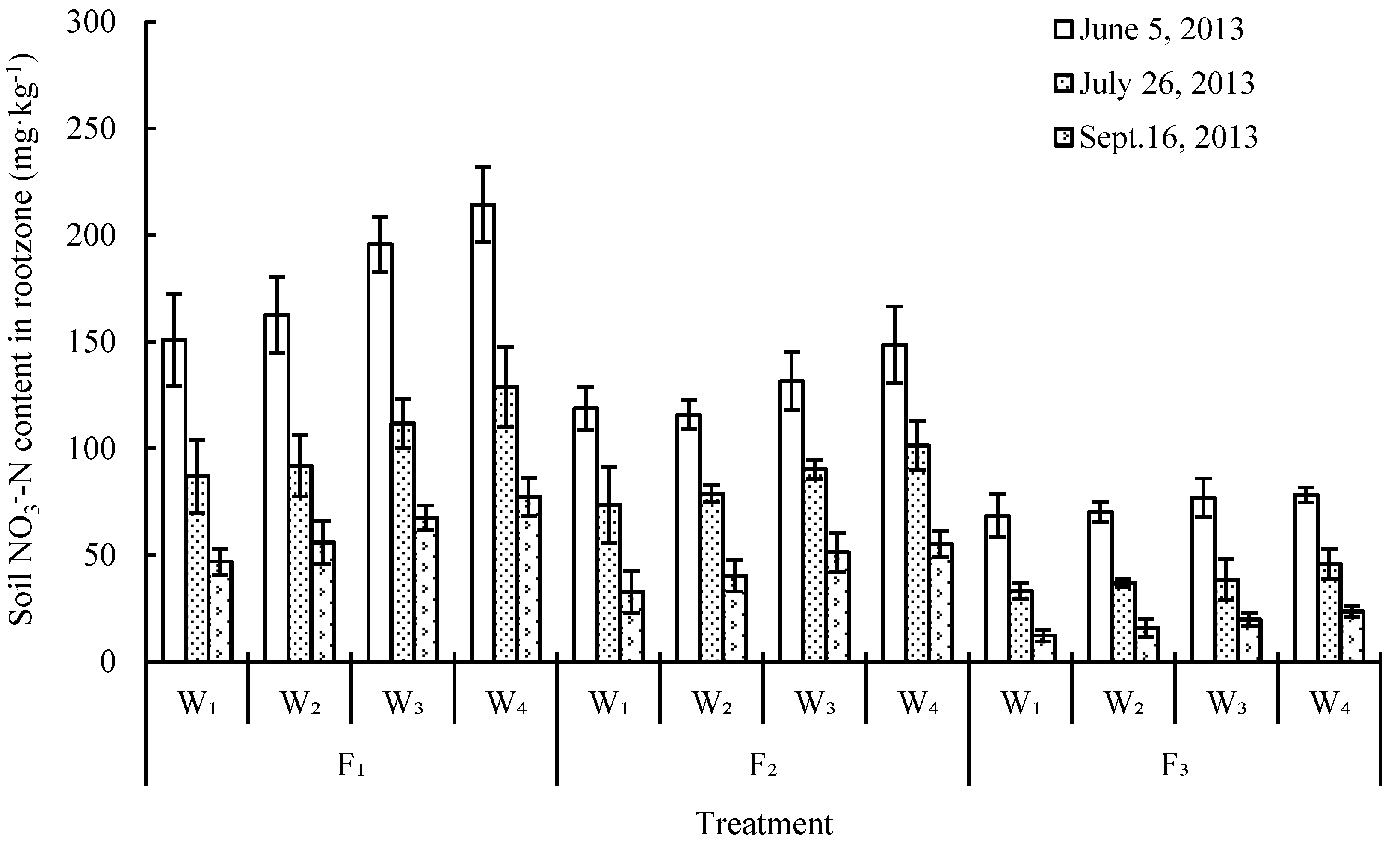

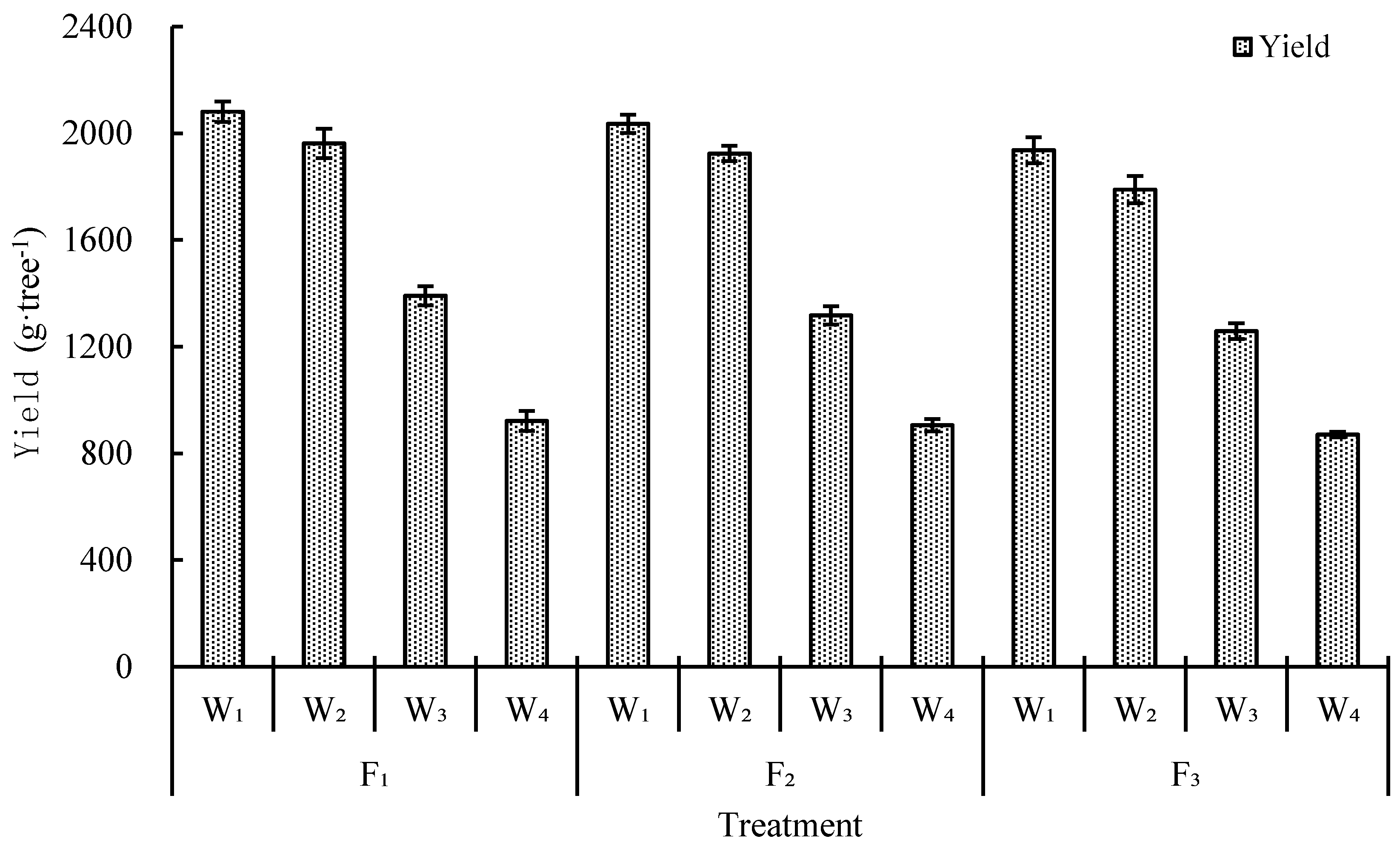

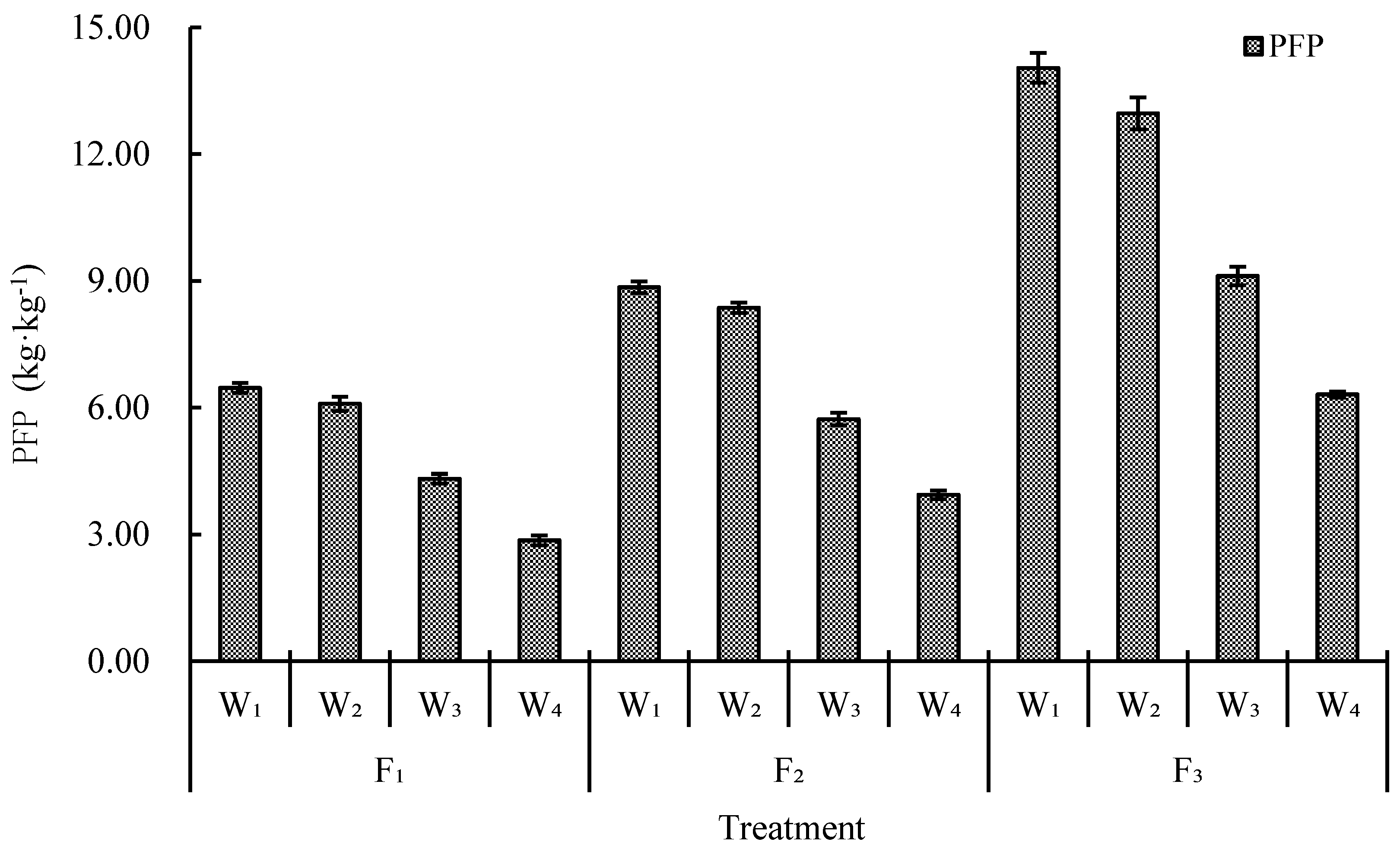
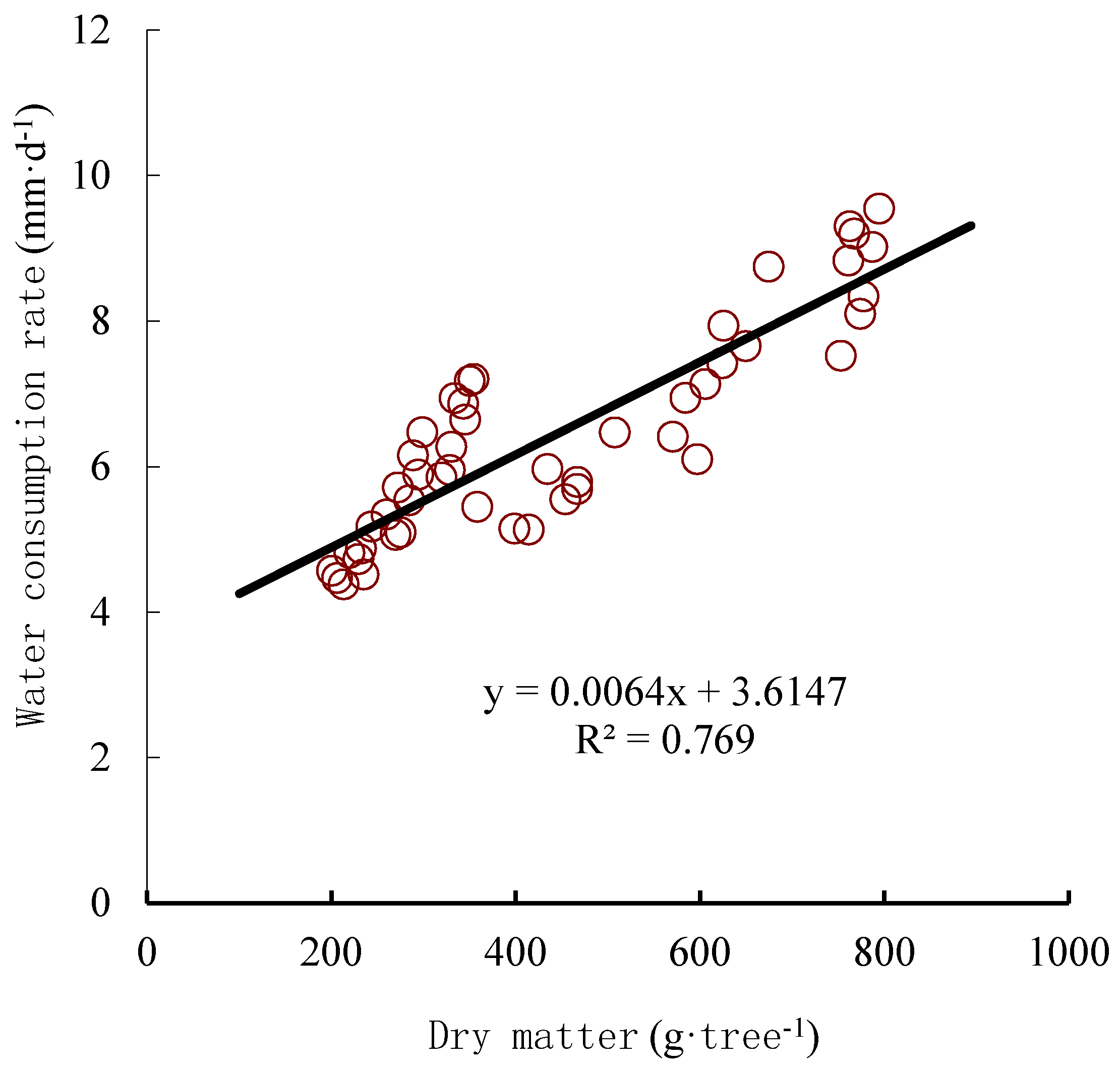
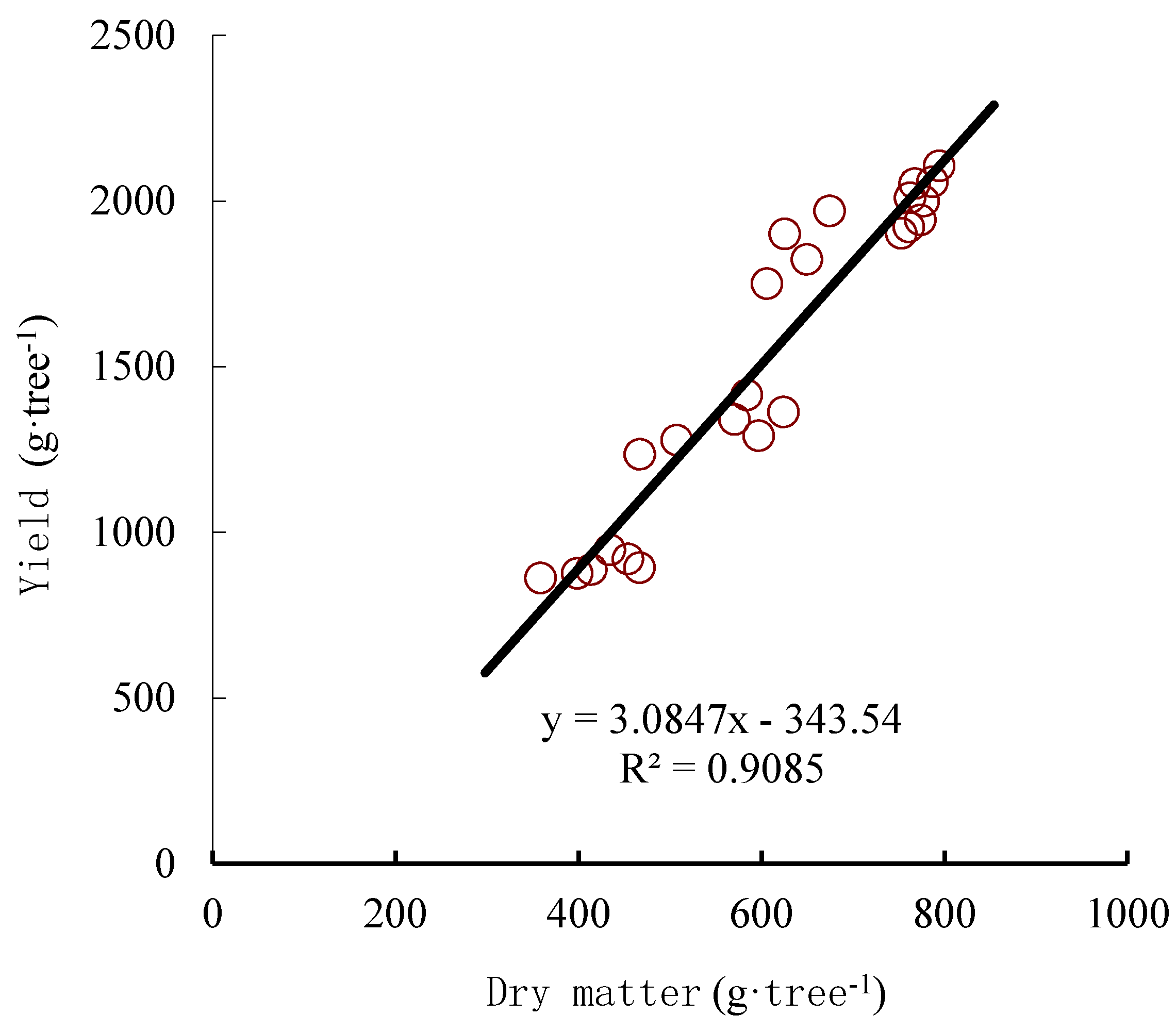
| Fertilizer Treatment | Water Treatment | Water Applied in 2012/(L·tree−1) | Water Applied in 2013/(L·tree−1) |
|---|---|---|---|
| F1 | W1 | 211.13 ± 6.07a | 280.97 ± 7.32a |
| W2 | 192.16 ± 8.72b | 254.95 ± 10.01bc | |
| W3 | 171.71 ± 8.45d | 214.51 ± 11.27d | |
| W4 | 143.43 ± 3.41fgh | 174.44 ± 7.71efg | |
| F2 | W1 | 209.70 ± 5.57a | 271.28 ± 5.56ab |
| W2 | 176.88 ± 4.25cd | 232.53 ± 14.62cd | |
| W3 | 152.94 ± 3.22ef | 187.23 ± 8.49e | |
| W4 | 134.53 ± 4.52h | 161.31 ± 9.96fg | |
| F3 | W1 | 188.10 ± 6.84bc | 248.75 ± 15.03bc |
| W2 | 165.71 ± 7.78de | 220.81 ± 11.07d | |
| W3 | 150.10 ± 7.39fg | 184.60 ± 13.11ef | |
| W4 | 136.34 ± 3.94gh | 159.21 ± 7.86g | |
| Test of significance (F value) | |||
| Water | 715.653** | 913.45** | |
| Fertilizer | 10.781 | 8.803 | |
| Water × Fertilizer | 1.971 | 0.851 | |
| Fertilizer Treatment | Water Treatment | Dry Matter/(g·tree−1) | Evapotranspiration/(L·tree−1) | CWP/(kg·m−3) |
|---|---|---|---|---|
| F1 | W1 | 341.47 ± 11.60ab | 208.01 ± 4.95a | 1.64 ± 0.01def |
| W2 | 337.27 ± 10.61ab | 190.33 ± 7.78b | 1.77 ± 0.01bc | |
| W3 | 288.93 ± 7.07cd | 168.45 ± 7.35c | 1.72 ± 0.04cd | |
| W4 | 224.13 ± 7.07f | 140.71 ± 1.81de | 1.59 ± 0.07efg | |
| F2 | W1 | 348.21 ± 7.78a | 207.32 ± 7.07a | 1.68 ± 0.01de |
| W2 | 323.67 ± 6.36b | 173.95 ± 2.12c | 1.86 ± 0.01a | |
| W3 | 271.97 ± 3.75de | 149.7 ± 0.72d | 1.82 ± 0.01ab | |
| W4 | 223.68 ± 15.20f | 131.22 ± 2.83e | 1.71 ± 0.08cd | |
| F3 | W1 | 293.18 ± 7.07c | 186.06 ± 6.65b | 1.58 ± 0.02fg |
| W2 | 265.52 ± 8.64e | 162.93 ± 7.78c | 1.63 ± 0.03def | |
| W3 | 237.32 ± 7.92f | 148.14 ± 6.31d | 1.60 ± 0.01efg | |
| W4 | 203.01 ± 3.90g | 133.24 ± 2.12e | 1.53 ± 0.05g | |
| Test of significance (F value) | ||||
| Water | 4143.262** | 1510.599** | 81.435** | |
| Fertilizer | 65.238* | 11.185 | 19.803* | |
| Water × Fertilizer | 2.606 | 2.503 | 1.228 | |
| Fertilizer Treatment | Water Treatment | Dry Matter/(g·tree−1) | Evapotranspiration/(L·tree−1) | CWP/(kg·m−3) |
|---|---|---|---|---|
| F1 | W1 | 780.44 ± 19.09a | 276.23 ± 7.17a | 2.83 ± 0.11cd |
| W2 | 768.78 ± 11.44a | 252.97 ± 10.19bc | 3.04 ± 0.17abc | |
| W3 | 603.63 ± 28.26bc | 28.26 ± 9.90d | 2.85 ± 0.10bcd | |
| W4 | 450.14 ± 22.88d | 171.82 ± 5.73ef | 2.63 ± 0.22de | |
| F2 | W1 | 774.26 ± 17.38a | 269.91 ± 5.96ab | 2.87 ± 0.13bcd |
| W2 | 762.82 ± 14.83a | 230.16 ± 12.01cd | 3.32 ± 0.11a | |
| W3 | 583.34 ± 18.79c | 184.44 ± 6.43e | 3.17 ± 0.21ab | |
| W4 | 433.58 ± 28.16d | 157.50 ± 8.70f | 2.75 ± 0.13cde | |
| F3 | W1 | 649.44 ± 34.64b | 245.83 ± 16.91c | 2.64 ± 0.14de |
| W2 | 627.37 ± 30.94bc | 217.94 ± 10.90d | 2.88 ± 0.10bcd | |
| W3 | 486.73 ± 28.66d | 180.65 ± 14.14e | 2.70 ± 0.15de | |
| W4 | 378.11 ± 28.42e | 156.20 ± 6.20f | 2.43 ± 0.28e | |
| Test of significance (F value) | ||||
| Water | 162.653** | 1699.485** | 10.482* | |
| Fertilizer | 64.605* | 8.391 | 42.924* | |
| Water×Fertilizer | 1.411 | 1.057 | 0.490 | |
© 2019 by the authors. Licensee MDPI, Basel, Switzerland. This article is an open access article distributed under the terms and conditions of the Creative Commons Attribution (CC BY) license (http://creativecommons.org/licenses/by/4.0/).
Share and Cite
Zhou, H.; Niu, X.; Yan, H.; Zhao, N.; Zhang, F.; Wu, L.; Yin, D.; Kjelgren, R. Interactive Effects of Water and Fertilizer on Yield, Soil Water and Nitrate Dynamics of Young Apple Tree in Semiarid Region of Northwest China. Agronomy 2019, 9, 360. https://doi.org/10.3390/agronomy9070360
Zhou H, Niu X, Yan H, Zhao N, Zhang F, Wu L, Yin D, Kjelgren R. Interactive Effects of Water and Fertilizer on Yield, Soil Water and Nitrate Dynamics of Young Apple Tree in Semiarid Region of Northwest China. Agronomy. 2019; 9(7):360. https://doi.org/10.3390/agronomy9070360
Chicago/Turabian StyleZhou, Hanmi, Xiaoli Niu, Hui Yan, Na Zhao, Fucang Zhang, Lifeng Wu, Dongxue Yin, and Roger Kjelgren. 2019. "Interactive Effects of Water and Fertilizer on Yield, Soil Water and Nitrate Dynamics of Young Apple Tree in Semiarid Region of Northwest China" Agronomy 9, no. 7: 360. https://doi.org/10.3390/agronomy9070360
APA StyleZhou, H., Niu, X., Yan, H., Zhao, N., Zhang, F., Wu, L., Yin, D., & Kjelgren, R. (2019). Interactive Effects of Water and Fertilizer on Yield, Soil Water and Nitrate Dynamics of Young Apple Tree in Semiarid Region of Northwest China. Agronomy, 9(7), 360. https://doi.org/10.3390/agronomy9070360





